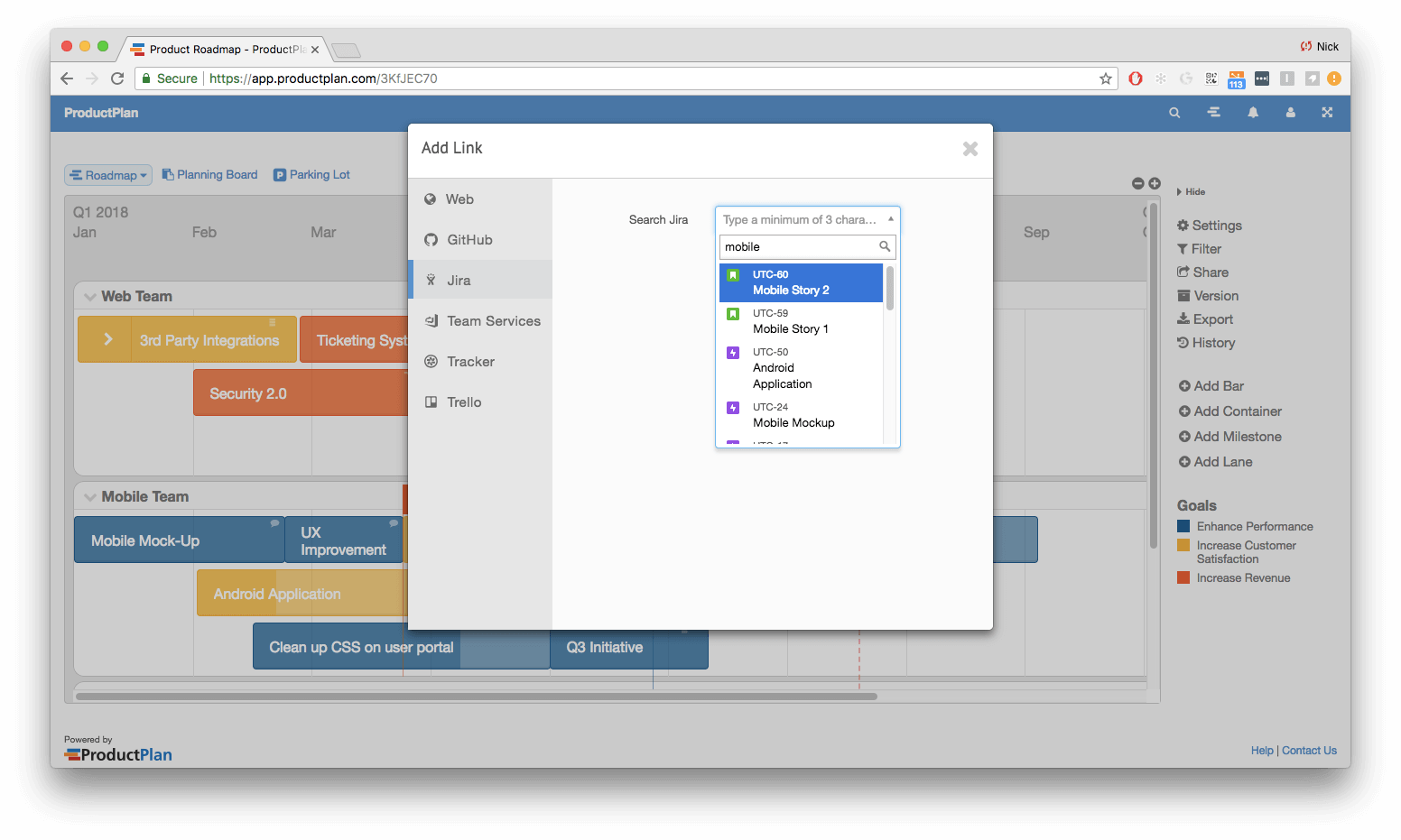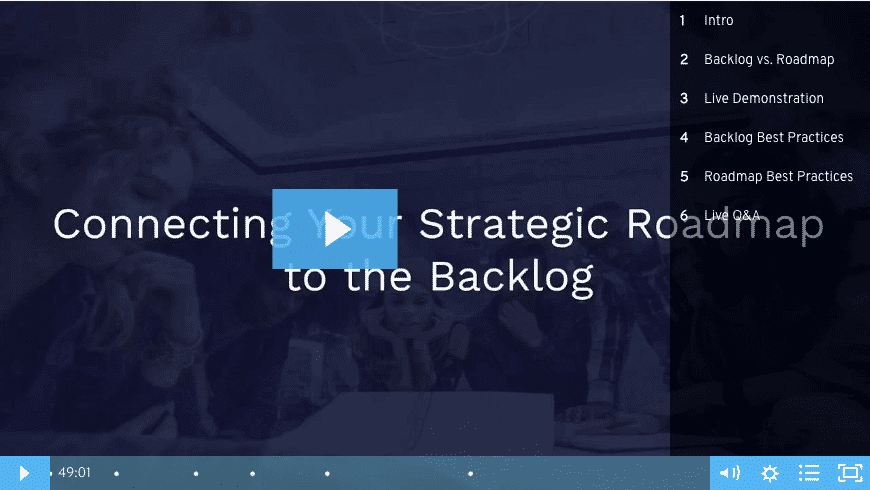The product roadmap and product backlog shepherd a product from the early strategic conceptualization to development to market release in two distinct and complementary ways. The product roadmap communicates high-level strategic objectives and priorities vs. the product backlog is a list of tasks that serve the roadmap’s strategic plan.
Product Roadmap vs. Product Backlog: 3 Key Differences
- The product roadmap includes high-level themes vs. the backlog includes task-level jobs such as stories and defects
- The product roadmap’s audience will include your executive team vs. the backlog is an internal document primarily for the product and development teams
- The roadmap conveys your strategy vs. the backlog conveys your plan to implement it
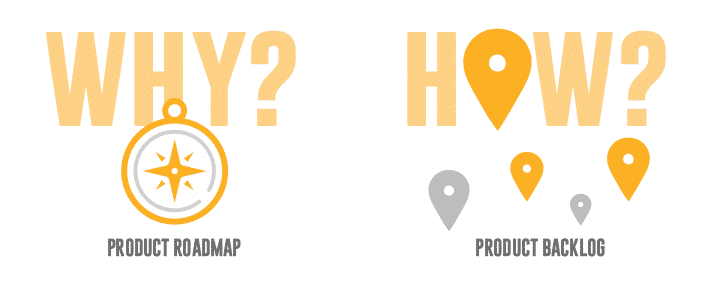
We will discuss these important concepts in more detail below. If you would like practical guidance on effectively connecting your backlog to your roadmap, click the video below to view the webinar that ProductPlan co-hosted with Atlassian Jira.
Defining the Product Roadmap and Product Backlog
Product Roadmap
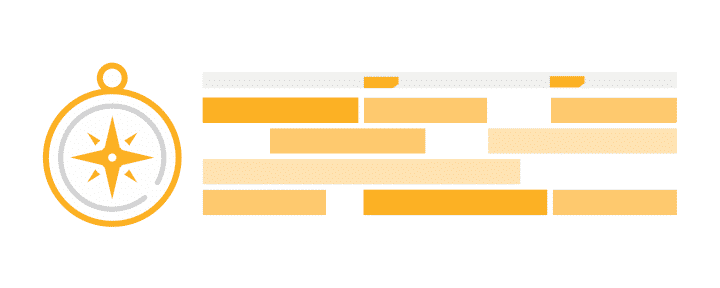 The product roadmap is a high-level tool to help a product manager capture, organize, and communicate their product’s strategic goals and plans. A quick glance at your roadmap should convey where you are taking your product over the coming months (and even years), as well as your strategic reasoning for doing so—whether it’s because of an opportunity you’ve identified in the market, strong user demand, competitive pressure, or a combination of factors. Typical items on a roadmap will include high-level product themes and possibly epics.
The product roadmap is a high-level tool to help a product manager capture, organize, and communicate their product’s strategic goals and plans. A quick glance at your roadmap should convey where you are taking your product over the coming months (and even years), as well as your strategic reasoning for doing so—whether it’s because of an opportunity you’ve identified in the market, strong user demand, competitive pressure, or a combination of factors. Typical items on a roadmap will include high-level product themes and possibly epics.
Product Backlog
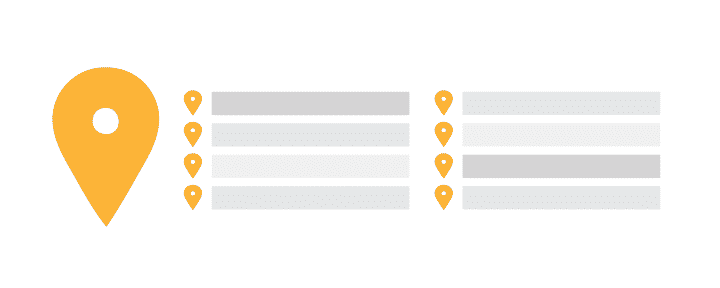
The product backlog lists and prioritizes the task-level details required to execute on the strategic plan set forth in the roadmap. A quick glance at your backlog should convey what’s next on your development team’s to-do list as they execute on your roadmap’s big-picture vision. Typical items on a product backlog include product stories, bug fixes, and other tasks.
Why the Product Roadmap and Product Backlog Must Be Separate
As you can see, the product roadmap and product backlog both serve important functions in a product’s development, but these functions are very different. This is why these tools should be used in conjunction with each other—but not interchangeably.
Without a high-level overview of your product’s strategic objectives and plans, you cannot effectively build a useful list of tasks, in priority order, for developing the product. So you need a standalone, clutter-free, strategic roadmap to capture and communicate this strategy.
At the same time, until you can translate your roadmap’s big-picture ideas and strategies into an actionable list of specific tasks—in other words, the backlog—your roadmap won’t do much good in helping you drive your product’s actual development, because you will not be able to tell your team specifically what to work on next. So, equally important to your roadmap is an organized and intelligently prioritized product backlog to help keep your development team focused on the right tasks at the right time.
This is also why you do not want to mix these two tools or use only one to serve both purposes. A roadmap with too much tactical detail can cause teams to lose sight of the strategic big picture, and a backlog that focuses on higher-level, strategic items can leave the team without a clear plan for what ground-level tasks to tackle next.
As we at ProductPlan have written often, your product roadmap is not your backlog.
Using the Product Backlog in Alongside the Product Roadmap
If the roadmap and backlog should be used together, as complementary tools, how should a product team go about this? Here are a few suggestions.
The Product Roadmap Comes First
Before you can begin prioritizing specific product development tasks, you first need to have an overarching strategic vision for the product—your “why.” You will almost certainly also need to receive the green light from your executive team and other stakeholders to move forward with your product’s strategic plan before you can begin deploying budget, developers’ time, and other company resources to executing on that plan.
For these reasons, you should develop your roadmap first—and determine your product’s high-level objectives, priorities, and plans. Then you can begin translating that big-picture strategy into a backlog of tasks, stories, and specific action items for your development team.
Always Keep Your Roadmap and Backlog in Sync
It will also be important that you make sure your roadmap and backlog are actually working together—which means they’re always in sync, and are both up-to-date, as opposed to becoming increasingly standalone documents that tell different stories.
In practical terms, this means regularly referring back to your roadmap to make sure the items prioritized on your backlog still represent the roadmap’s strategic objectives and priorities. It also means always keeping your backlog organized and lean, and never allowing it to become a black hole where everyone simply throws in their ideas and requests.

Use Purpose-Built Task Management & Roadmap Software Apps to Make Connecting Both Tools Easy
Finally, the easiest and most effective way to synchronize your roadmap and backlog will be to use the right tools to create and maintain both—ideally, purpose-built web apps that communicate with each other and allow you to connect your roadmap and backlog directly.
One example of this scenario would be to use the integration between ProductPlan’s web-based roadmap app and Jira’s project management software, so you can connect your product roadmap to your backlog and convert strategic plans directly into task-level details, and vice versa. The screenshot below depicts what that would look like:
